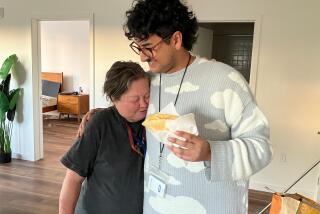Rehabilitation Center’s Patients Find Shopping Truly Is Therapy
- Share via
David Frazer was struggling.
His left hand, encased in a plastic brace, is severely weakened. So he improvised as he made a cheesecake for Thanksgiving dinner, grasping a bag full of graham cracker crumbs in his trembling right hand and tearing it open with his teeth. His therapist nodded approvingly.
“I hope my wife never sees this,” Frazer, 81, said, “or I’ll be cooking at home!”
Frazer was refining his culinary skills in an unlikely setting: a hospital. The Malibu resident is still recovering from a stroke suffered Oct. 9. But therapists are hoping that the rituals of the holidays will help him--and other patients--to heal.
As part of an unusual regimen at UCLA Medical Center’s Neurological Rehabilitation and Research Unit, Frazer helped shop for and prepare an elaborate feast.
Today, he will sit down with family, fellow patients and hospital staff to enjoy a traditional Thanksgiving meal--one of many transitional steps to a normal life.
“Most patients in rehabilitation have been dealt a really devastating illness or injury,” said Suzann Lawrence, assistant director of the unit. “One minute they’re fine and the next they’ve lost some incredibly important function like walking or swallowing. Our goal is to get the patient to a level where they’re most independent, before they go home.”
Typically, patients at the rehabilitation facility have suffered strokes, spinal cord damage or brain injuries, or are battling multiple sclerosis, said Stacy Nonoguchi, recreation therapist.
Many basic skills have to be learned again before patients can go home, so they spend two to three weeks at the rehabilitation center. Allowing patients to do something as simple as preparing a meal lets the staff see their level of recovery, Nonoguchi said.
More importantly, it gives the patients a welcome dose of the usual.
“Preparing for Thanksgiving allows the patients and their family to do something normal,” Nonoguchi said. “It allows them to focus on the holiday, instead of themselves or their condition.”
The rehabilitation unit opened in 1994. Patients have been celebrating holidays at the cozy 11-bed facility since 1995, Nonoguchi said.
“They take ownership of their own rehab,” she said. “They take charge of the shopping and the preparation, and they get to see the end result.”
Frazer had a difficult time dealing with his decreased abilities. The self-described “cabinetmaker, carpenter, jack-of-all trades” was frustrated by his body’s refusal to “cooperate.”
Married 59 years, Frazer built his own house almost 40 years ago, and tried to retire three times.
“I kept going back. It’s always fun working,” he said.
Like most stroke victims, Frazer has been battling depression throughout his rehabilitation. But he responded well to the therapy.
Last Friday afternoon he sat in his wheelchair, back straight, eyes expectant, as he waited for Nonoguchi to accompany him and Winifred Duvoisin, also recovering from a stroke, to the grocery store.
Frazer’s goal for the day was to work on his wheelchair mobility. The small Westwood store posed a challenge, as he maneuvered through narrow, uneven aisles, straining and reaching to pluck tortilla and potato chips off the shelves.
“These are for watching the football games,” he explained cheerfully.
*
On Wednesday afternoon, as he smoothed the cheesecake batter, a rakish smile slowly spread over his face.
“I can make blueberry muffins too, ya know,” he boasted to his therapists. “That’s Sunday breakfast for me and my wife.”
Frazer will go home Friday, and continue therapy at home. He expects rehabilitation to take months, or possibly years.
“Our whole life has turned around,” he said. “But my doctor says I can beat it, so I’m trying. I’m just going to keep at it.”


